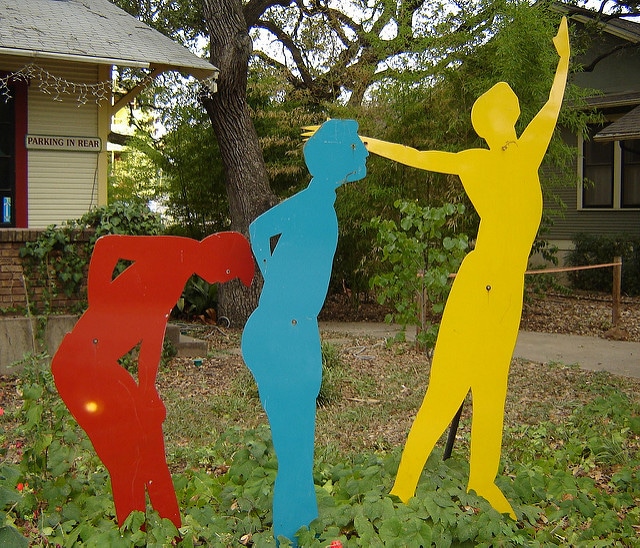
Zendo Project psychedelic harm reduction training at Burning Man. Image courtesy of the Zendo Project.
You find yourself at one of your favorite transformational art and music festivals, and things are extra exciting because, this year, you are attending as a volunteer, not just a participant. As someone who has had positive and life-changing experiences with psychedelics but also knows the challenges they may bring, you decide to volunteer with the onsite psychedelic harm reduction team so that you can help others who are navigating this sometimes difficult but often beautifully transformational space.
You feel deep down that this is the right way for you to be volunteering at your favorite festival, but waves of nervousness come across you, making you question if you are adequately prepared to assist people who are experiencing bad trips and are seeking help. “How crazy might things get,” you wonder, “and will I know what to do?”
As you arrive for your training and first shift as a psychedelic harm reduction volunteer, you don’t know what to expect, other than the unexpected. The role you are stepping into is both ancient and modern, and understanding the similarities, differences, and nuances between ancient shamanic practices and modern festival-going and harm reduction will put things into perspective and help you be of service in the best way possible.
The Legacy of Transformational Events
Modern day transformational festivals trace their roots to the ancient, fundamental human urge to gather together in celebration with music, art, performance, and the perturbation of consciousness. But unlike shamanic cultures, where such celebrations were overtly religious and central to tribal life, modern festivals in Western culture are viewed as weekend recreational excursions. Many people do have transformational or “spiritual” experiences at these festivals (such experiences are often encouraged and celebrated), but they are not wound into the fabric of the event with any central mythology, religion, or ideology.
Because of this, these events attract a broad spectrum of participants with diverse beliefs. The people who do use them as a transformational psychedelic ritual (either consciously or by accident) are often left to do it themselves and must rely on their immediate friends for support if things go awry. This is where psychedelic harm reduction services step in—to fill the vital gap of psychedelic support in a modern, secular way that helps people undergoing difficult experiences and reduces potential harm.
The Shaman and the Harm Reduction Specialist
Psychedelic use goes back to the dawn of human civilization, and the role of assisting people as they journey into altered realms of consciousness is just as ancient. Within indigenous shamanic cultures, the role of the shaman was central to the health and well-being of the tribe. They served not only as an imbiber of psychedelics to journey to alternate realms, but also as a guide for others, wearing the hats of counselor, doctor, and many more. But unlike the extremely broad traditional role of the shaman, modern day psychedelic harm reduction volunteers and specialists have a much narrower focus.
Psychedelic harm reduction specialists are not guides, doctors, spiritual leaders, or therapists. Their goal is very simple: to reduce harm and offer a helping hand. Most often this means sitting down and talking people through their challenging psychedelic experiences, offering an empathetic ear and a grounding and reassuring presence that assures them that “this too shall pass.” The rare people who are in need of medical attention or are erratic and potentially dangerous are handled by the onsite medical and security teams, so those who are handled by the psychedelic harm reduction team are simply people who are feeling overwhelmed with what they are experiencing and looking for emotional support. Rather than guiding people through the astral planes, bringing light on their darkest secrets and traumas, or initiating them into adulthood, the harm reduction volunteer simply listens, supports, comforts, and reassures as the journey takes its course. They are not a guide, but simply a benevolent witness.
The simple fact that you exist as part of a harm reduction team and have a safe and supportive space is a godsend to the people who arrive seeking help, who would otherwise be freaking out, thinking they need to go to the hospital when they don’t, or getting into dangerous or ill-advised situations.
Stepping Into Service
If being a psychedelic harm reduction volunteer sounds rewarding to you, there are many ways to step into service at events like Burning Man, Lightning in a Bottle, regional burn events, and countless other festivals across the US and around the world.
Reach out to the festival volunteer coordinators to find out who is leading their harm reduction group, and sign up for a shift. There are many protocols, tips, and best practices that you will learn to equip you for volunteering at that specific event, and hopefully, this article has helped you to understand the bigger picture regarding your role, the historical context of that role, and the importance of this kind of work.
Additionally, for people who want to take harm reduction service to the next level, there are certification programs from universities like CIIS and private institutions like Being True to You that can make this kind of work your vocation and livelihood.









